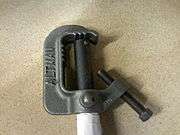C-Clamp (stagecraft)

In stagecraft, a c-clamp can refer to a number of different pieces of hardware, depending on its intended use.
Lighting and sound
In stage lighting and sound a c-clamp, also referred to as a pipe clamp, is used to attach a larger piece of hardware, such as a lighting instrument, a speaker, or a dimmer, to a pipe or batten. Newer c-clamps tend to be constructed of aluminum, although steel is also available.
C-clamps function by affixing a bolt (the "shaft bolt") to the hardware they are to hold in place, such as through the yoke of a lighting instrument, and securely fastening this bolt to the clamp shaft. The open end of the clamp is then placed over the batten, and a bolt (the "clamp bolt") is tightened to secure the c-clamp. C-clamps for stage lighting fixtures usually also have a pan screw (also known as a "grub bolt"), which when loosened will allow the clamp shaft, and therefore the fixture, to be rotated 360 degrees while maintaining a secure connection to the batten.
When using c-clamps care must be taken to not over-torque the clamp bolt which affixes the clamp to the batten. If this bolt is overtightened, it can easily dimple or "drill" into the batten seriously compromising the strength of the batten.
Parts
- Clamp: the main body of the clamp, is typically either cast steel or aluminium and designed to sit overtop of a typical theatrical batten.
- Clamp Bolt: a long-threaded bolt (typically 9/16") designed to tighten down on a pipe, forcing it into the clamp.
- Spigot: a machined metal shaft that sits in the clamp and rotates freely through 360°. Used for attaching Stage lighting instrument or other fixture to the c-clamp.
- Pan Bolt: A small bolt through the side of the clamp, typically 1/4" or 3/8" which tightens down onto the spigot, preventing it from rotating (panning).
- Yoke Bolt: A short 1/2" bolt which affixes the yoke of a fixture to the spigot.
Variations
- Pipe Clamp
- G clamp
- Trigger Clamp
- Cheseborough[1] / swivel coupler[2] / double coupler[3] and half-burger / half coupler[4]
- Manfrotto Super Clamp
Film and television
Film and television grips commonly make use of c-clamps that are manufactured specifically for their industry. These clamps are produced with integrated studs designed to accept the mounting hardware from a variety of small, lightweight lighting fixtures, allowing illumination to be placed in unusual or awkward locations quickly and easily.
Carpentry

C-clamps are commonly used in theatrical carpentry for the same purpose that non-theatrical carpenters employ them: for creating a quick, temporary, and non-destructive way of joining two objects together. Legs are commonly attached to platforms via c-clamp before they are fastened together using a more permanent method (i.e. bolts). Multi-platform assemblies are also commonly joined to one another solely with c-clamps, especially in touring situations where a set needs to be assembled and struck quickly.
References
- Friedman, Sally (1994). Backstage Handbook: an illustrated almanac of technical information., Broadway Press.